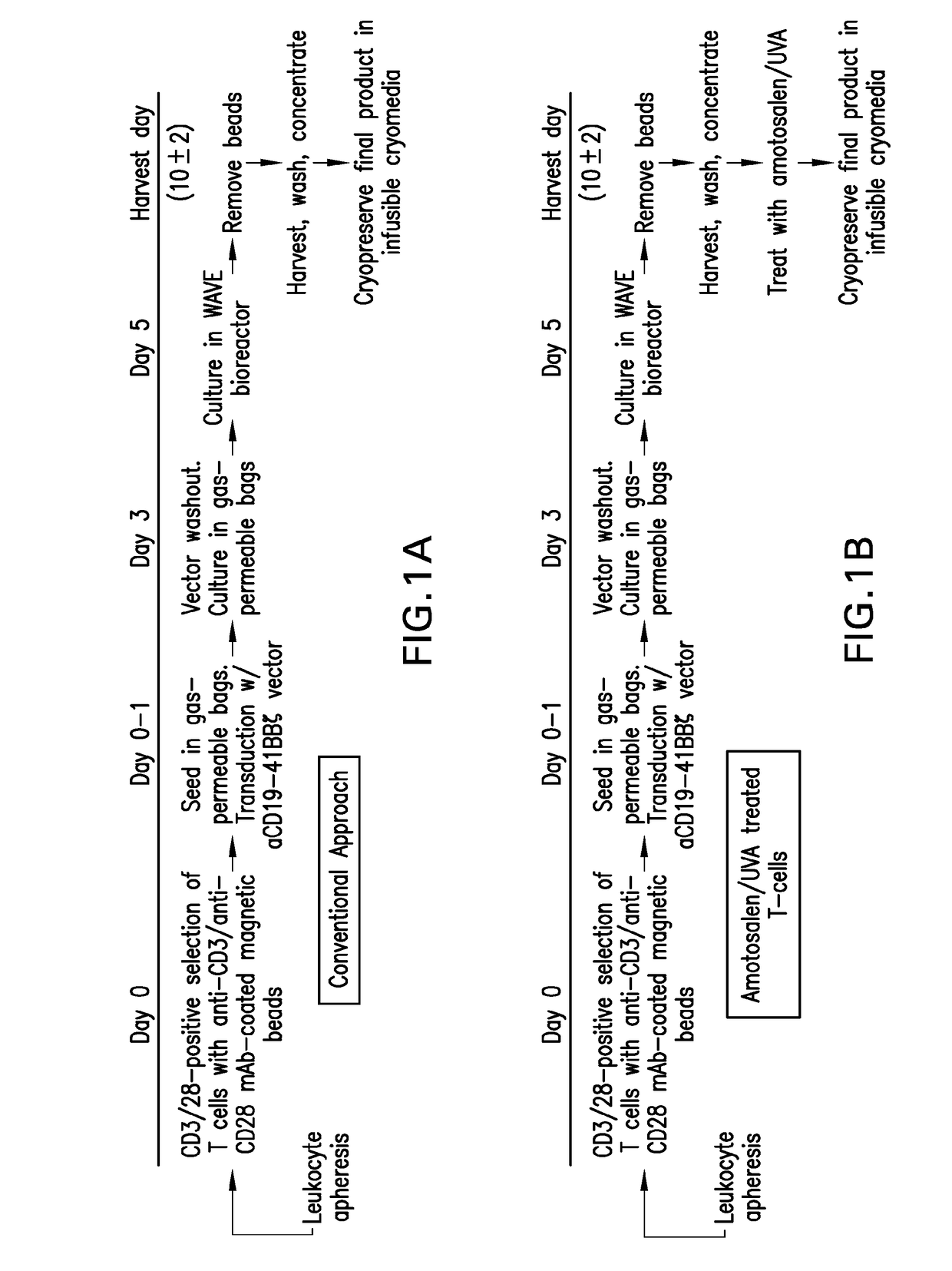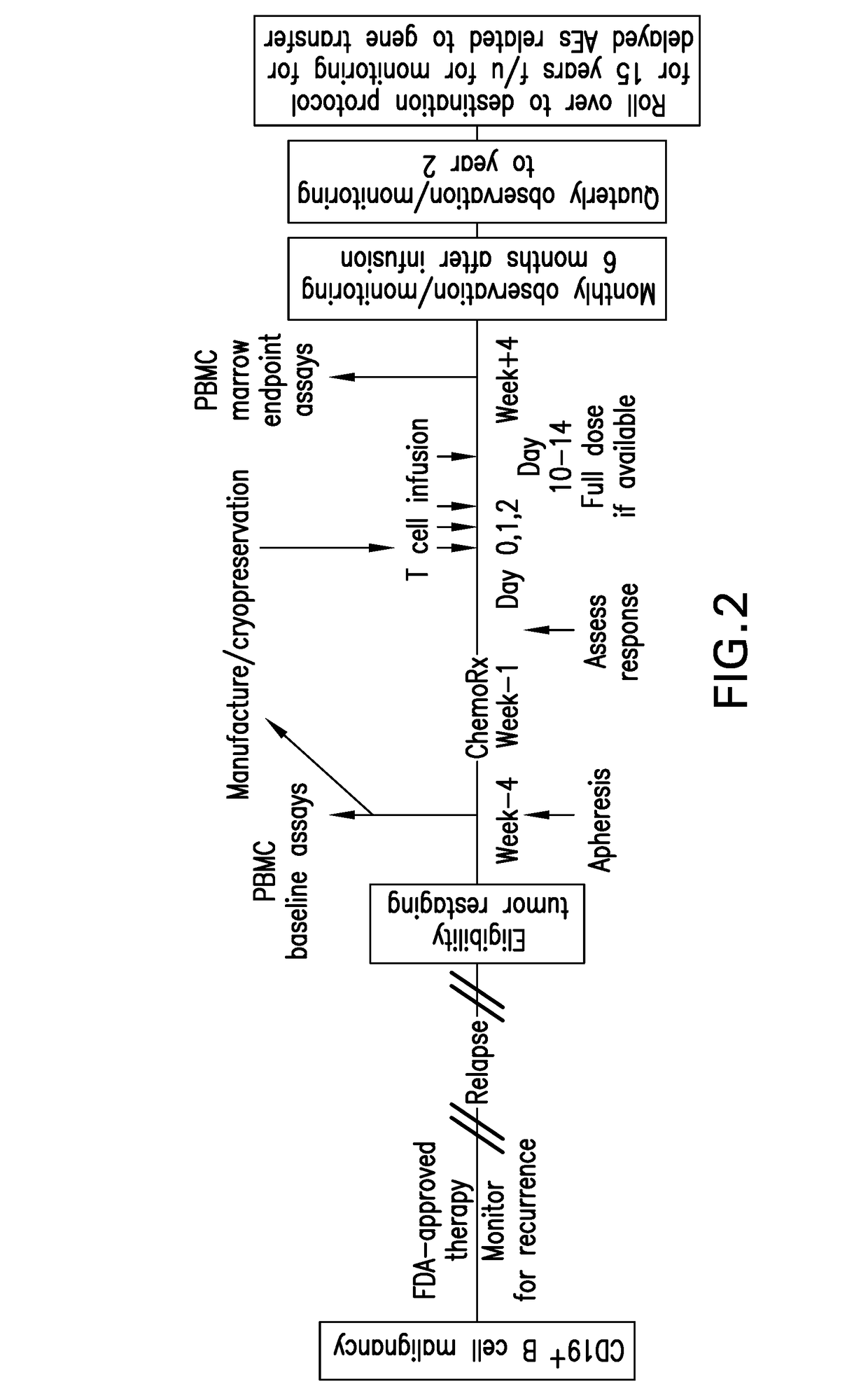Compositions and methods for improved car-t cell therapies
a technology of t cell therapy and composition, applied in the direction of drug compositions, immunoglobulins, peptides, etc., can solve the problems that the engagement of the cd4sup>+/sup> and cd8sup>+/sup> t cell receptor (tcr) alone is not sufficient to induce persistent activation of resting naive or memory t cells, and achieves the effect of reducing the number o
- Summary
- Abstract
- Description
- Claims
- Application Information
AI Technical Summary
Benefits of technology
Problems solved by technology
Method used
Image
Examples
example 1
Mice with OVA Expressing Tumor Line (N=6-8 Mice Per Arm)
[0094]Specific pathogen-free, C57BL / 6 (CD45.2, Thy-1.2), CD45.1, and Thy-1.1 congenic mice and OT-1 mice on a C57BL / 6 (H-2b) background are obtained from commercial sources. The OT-1 mice express a transgenic TCR Va2 and Vb5 specific for the
[0095]SIINFEKL peptide of OVA in the context of MHC class I, H2-Kb. Homozygous perforin2 / 2, TNF2 / 2 (OT-1.TNF), and IFN-g2 / 2 (OT-1.IFN-g) deficient C57BL / 6 mice are generated by backcrossing OT-1 mice onto specified syngeneic deficient mice (H-2b) and the OT-1, cytokine-deficient, mice are selected from the F2 generation and obtained from commercial sources.
[0096]The OVA-transfected B16 tumor cell line (B16-OVA) is obtained from commercial sources and maintained in RPMI 1640, supplemented with 10% heat-inactivated FBS, 2 mmol / l L-glutamine, 100 mg / ml kanamycin, 50 mmol / l 2-ME, 0.024 mmol / l sodium bicarbonate, and 600 mg / ml G418 (Invitrogen. Carlsbad, Calif.).
example 2
ompatible CD8 T-Cells with OVA Specificity / Expand when Necessary
[0097]Spleens and lymph nodes are collected from OT-1 mice (7-8 weeks of age) and single-cell suspensions prepared by mechanical disruption. Cells are washed and resuspended in RPMI 1640 medium supplemented with 10% FBS, 1 mmol / l MEM sodium pyruvate, 0.1 mmol / l MEM nonessential amino acids, 2 mM L-glutamine, 100 IU penicillin, 100 mg / ml streptomycin (Invitrogen), 45 μM 2-ME (Sigma-Aldrich, St. Louis, Mo.). Live cells are obtained by density gradient centrifugation with Lympholyte M (Cedarlane Laboratories, Hornby, Ontario, Canada). Fc receptor binding is blocked with 2 mg / ml 2.4G2, and cells stained with anti-CD44 microbeads and CD44hi cells are depleted. The remaining CD8+ CD44lo T cells are isolated by negative selection using a CD8+ T cell kit (Miltenyi Biotech, Auburn, Calif.) according to the manufacturer's protocol.
[0098]To obtain effector cells to OVA peptide, single cell suspensions from spleen and lymph nodes o...
example 3
of Activated Cells with Amotosalen
[0103]The cell suspensions in RPMI aliquots (5 mL in 6 well plates, or equivalent vesicle), are dosed with 33 μL of stock solutions of amotosalen (15 mM, 1.5 mM, 150 μM, 15 μM, 1.5 μM) to final concentrations of amotosalen in the photo-illumination container of 100 μM, 10 μM, 100 nM and 1 nM, respectively. The solutions are illuminated with UVA light to a final dose equivalent of 3 J / cm2 in a UVA illumination device. The illumination device is a microprocessor-controlled system that consists of two banks of UVA lights (me F15T12 BLB lamps, Spectronics Corp., New York, N.Y.) that deliver UVA light to the top and bottom of the plastic containers. Photodiodes continually monitor the output from the lamps. The microprocessor integrates the photodiode signals and adjusts the exposure time so that the previously programmed dose is delivered to within 0.1 J per cm2. An internal cooling fan keeps the container with cells near the ambient temperature (22-24°...
PUM
| Property | Measurement | Unit |
|---|---|---|
| Fraction | aaaaa | aaaaa |
| Composition | aaaaa | aaaaa |
Abstract
Description
Claims
Application Information
 Login to View More
Login to View More - R&D
- Intellectual Property
- Life Sciences
- Materials
- Tech Scout
- Unparalleled Data Quality
- Higher Quality Content
- 60% Fewer Hallucinations
Browse by: Latest US Patents, China's latest patents, Technical Efficacy Thesaurus, Application Domain, Technology Topic, Popular Technical Reports.
© 2025 PatSnap. All rights reserved.Legal|Privacy policy|Modern Slavery Act Transparency Statement|Sitemap|About US| Contact US: help@patsnap.com


